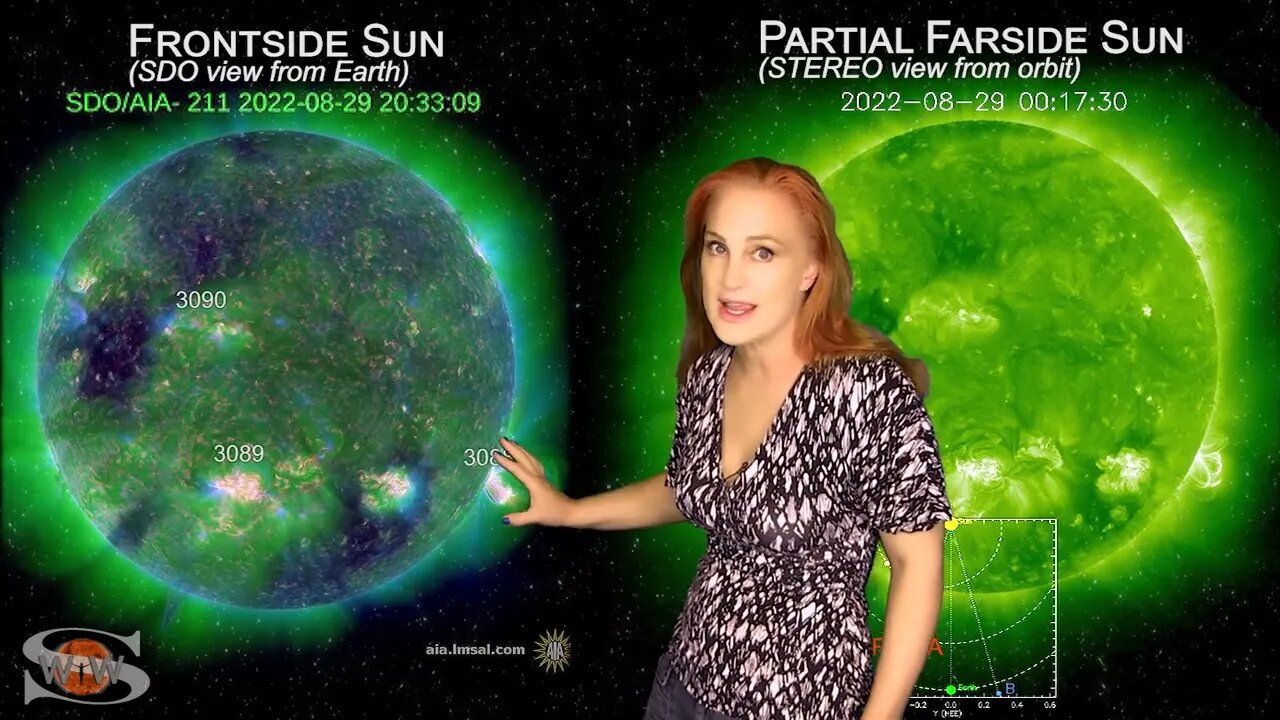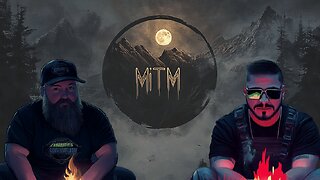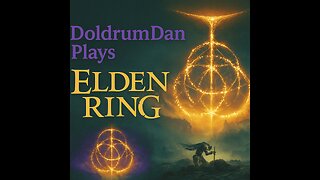Premium Only Content

Fast Wind Comes Before Flares Return | Space Weather News 09.02.2022
This Space Weather News forecast sponsored in part by Millersville University:
https://www.millersville.edu/swen
This week our Sun is trading big flare-players for a nice chance for aurora. We say goodbye to region 3088 as it rotates off the Sun's west limb and to the farside. Guaranteed we will keep a close watch on it to see whether it survives the next two weeks and will return. Meanwhile we have a large coronal hole that will be sending us some fast solar wind starting around September 4th. Last month this coronal hole bumped us to G2-level storm conditions and there is a good chance it will do the same this time as well. Aurora photographers should get ready for a decent show, even down to mid-latitudes as we could see some sustained views ramping up late September 3, peaking on September 4 through 5, and then ramping down through September 6 and 7. Overall, this could make up for some of the solar storm fizzles we have seen from the big flare players (who obviously have very bad aim). Amateur radio operators and GPS users may get a bit of a reprieve on Earth's dayside from radio blackouts this week, but once the solar storm hits, expect signal disruptions on Earth's nightside, especially anywhere near aurora. Learn the details of the coming solar storm, watch region 3088 rotate out of view with a bang, & see why the radio-quiet conditions will not last for long, with new regions about to rotate into view.
Want early access to these forecasts, tutorials on Space Weather, & more? Visit:
https://patreon.com/SpaceweatherWoman
For daily and often hourly updates (during active times) visit me on Twitter:
https://twitter.com/TamithaSkov
For a more in-depth look at the data and images highlighted in this video see these links below.
Solar Imaging and Analysis:
SDO: http://sdo.gsfc.nasa.gov/data/
Helioviewer: http://www.helioviewer.org/
Flare Analysis: http://www.lmsal.com/solarsoft/latest_events/
Computer Aided CME Tracking CACTUS: http://www.sidc.oma.be/cactus/out/latestCMEs.html
GOES Xray: http://www.swpc.noaa.gov/rt_plots/xray_1m.html
SOHO: http://sohodata.nascom.nasa.gov/
Stereo: http://stereo.gsfc.nasa.gov/
GONG magnetic field synoptic movie: https://gong.nso.edu/data/magmap/standard_movie.html
GONG magnetic field synoptic charts: http://gong.nso.edu/data/magmap/
LMSAL Heliophysics Events HEK http://www.lmsal.com/isolsearch
Solar Wind:
DISCOVR solar wind: http://www.swpc.noaa.gov/products/real-time-solar-wind
ACE Solar Wind: http://www.swpc.noaa.gov/products/ace-real-time-solar-wind
NASA ENLIL SPIRAL: https://iswa.gsfc.nasa.gov/IswaSystemWebApp/iSWACygnetStreamer?timestamp=2038-01-23+00%3A44%3A00&window=-1&cygnetId=261
NOAA ENLIL SPIRAL: http://www.swpc.noaa.gov/products/wsa-enlil-solar-wind-prediction
Magnetosphere, Ionosphere, Atmosphere:
GOES Magnetometer: http://www.swpc.noaa.gov/products/goes-magnetometer
Ionosphere D-Region Absorption (DRAP) model: http://www.swpc.noaa.gov/products/d-region-absorption-predictions-d-rap/
Radio Propagation: https://www.tvcomm.co.uk/g7izu/atlantic-mf-hf-propagation-20min-persistence/
Near-Earth radiation environment: https://spaceweather.gfz-potsdam.de/products-data/forecasts
Auroral Oval Ovation Products: http://www.swpc.noaa.gov/products/aurora-30-minute-forecast
Global 3-hr Kp index: http://www.swpc.noaa.gov/products/planetary-k-index
Wing Kp index prediction: http://www.swpc.noaa.gov/products/wing-kp
USGS Ground Magnetometers: http://geomag.usgs.gov/realtime/
USGS Disturbance Storm-Time (Dst): http://geomag.usgs.gov/realtime/dst/
NAIRAS Radiation Storm Model: http://sol.spacenvironment.net/raps_ops/current_files/globeView.html
Multi-Purpose Space Environment Sites:
NOAA/SWPC: http://www.swpc.noaa.gov
SOLARHAM: http://www.solarham.net/index.htm
Spaceweather: http://spaceweather.com
iSWA: http://iswa.gsfc.nasa.gov/iswa/iSWA.html
Definition of Geomagnetic Storm, Radiation Storm, and Radio Blackout Levels:
http://www.swpc.noaa.gov/NOAAscales/
None of this would be possible without the hard work and dedication of those who have provided all of this data for public use.
Images c/o NASA/ESA/CSA (most notably the superb SDO, SOHO, ACE, STEREO, CCMC, JPL & DSN teams, amazing professionals, hobbyists, institutions, organizations, agencies and amateurs such as those at the USAF/HAARP, NICT, NOAA, USGS, Environment Canada, Natural Resources Canada, Intellicast, Catatania, rice.edu, wisc.edu, sonoma.edu ucalgary.ca, rssi.ru, ohio-state.edu, solen.info, and more. Thanks for making Space Weather part of our every day dialogue.
-
 14:35
14:35
Dr. Tamitha Skov
1 year ago $0.02 earnedBig Flares, Mini-Storms & A Whole Lot of Eye Candy | Solar Storm Forecast 10 December 2023
2661 -
 1:25:04
1:25:04
RCAM
1 hour agoWorld of Warcraft: The War Within | Mount Farming w/ Friends | Gaming on Rumble | Premium Creator
1.6K -
 LIVE
LIVE
Midnight In The Mountains
2 hours agoMidnight In The Mountains | Episode 6 | Feat: Joker & VapinGamers | Caught On Camera!
185 watching -
 12:23
12:23
Exploring With Nug
23 hours ago $4.05 earnedSUV Found In Private Pond While Searching For Missing Man!
23.1K6 -
 LIVE
LIVE
DoldrumDan
4 hours agoLEVEL 1 HITLESS GLADIUS NIGHTREIGN INTO ELDEN RING DLC
43 watching -
 53:57
53:57
Tactical Advisor
6 hours agoUnboxing New Guns and Mystery Box | Vault Room Live Stream 033
47.1K7 -
 LIVE
LIVE
Reolock
4 hours agoWoW Classic Hardcore | Blizzard Screwed Up... AGAIN
30 watching -
 1:15:16
1:15:16
Jeff Ahern
8 hours ago $10.13 earnedThe Saturday Show with Jeff Ahern
46.8K6 -
 LIVE
LIVE
RJTWIN
1 hour ago🔴LIVE - Gaslighting the Gulag Warden | Warzone | Clean Content - !blerp !discord !rumbot
22 watching -
 1:38:52
1:38:52
Michael Franzese
21 hours agoEpstein. Diddy. Coverups. What the Government Isn’t Telling You
87.1K180